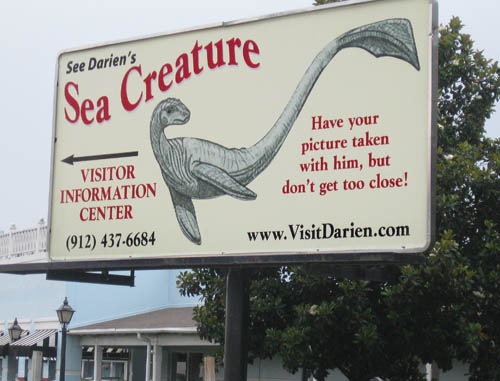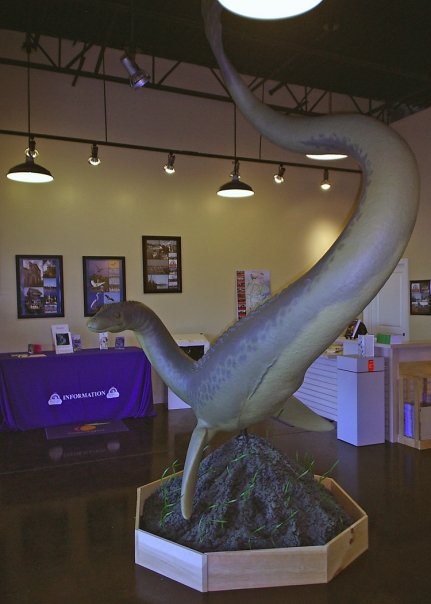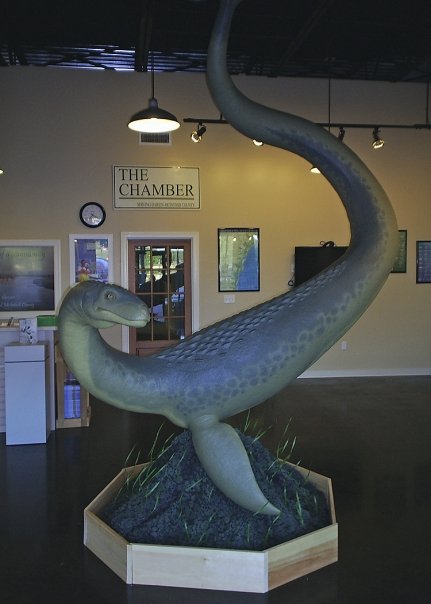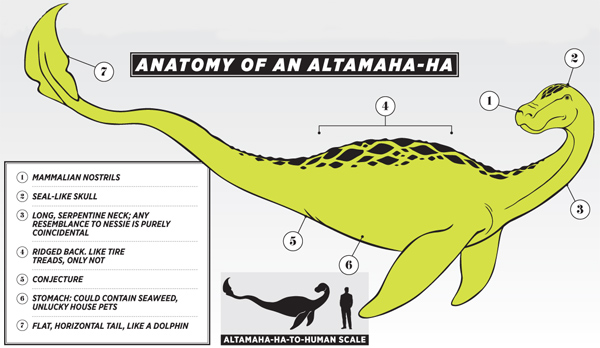
June 5, 2011
Altie may not be real, but yeah, it’s a thing
Curt Holman
Creative Loafing Atlanta
An alligator spies on my family as we stand on a midden heap on a muddy bank of the South Altamaha River. Our flip-flops crunch on the jagged oyster shells and pottery shards cast off by Native Americans a couple of centuries ago. Our guide points out their importance to the history of coastal Georgia, but I can’t pay proper attention. I’ve brought my family to Darien in search of a monster.
Squinting in the midday sun, I can see the alligator’s eyes and snout protruding from the water about 50 yards away. Our guide, Danny Grissette, says it’s 8 to 9 feet long, making it no match for my potential prey, an aquatic beast alleged to be at least 20 feet in length. Wait, could that be the creature’s famed ridged hump? No, it’s just a stump sticking out of the brown river water. What about that mysterious turbulence about 25 yards away? It could be the wake of an unseen ship or a school of fish. But can we prove that it’s not the tell-tale sign of the legendary entity known as the Altamaha-ha?
The Altamaha-ha, known more casually as “Altie,” defies scientific explanation. Even before European settlement, the Tama tribes people told stories of a giant, snake-like river animal that hissed and bellowed. Over the past century, fishermen, lumberjacks and boy scouts have reported sightings of a creature in the tributaries and marshes of the Altamaha River, which feeds one of the largest river basins on the Atlantic Coast. The eyewitness consensus holds that the Altamaha-ha has a dark, smooth hide, apart from the tire-tread-like ridges on its back, as well as a narrow neck, prominent snout and flat, porpoise-like tail.
Could it be a sturgeon on steroids? A throwback to marine reptiles like the toothy plesiosaur? Maybe the Loch Ness Monster’s cousin from across the pond? I’m skeptical about cryptids, the kind of famous beings like Bigfoot unrecognized by the scientific establishment, but the Altamaha-ha called me with a siren song, despite the likelihood of a search turning into a snipe hunt. But even if the Altamaha-ha isn’t real, it could still have significance.
I grew up in Georgia and totally dug on Leonard Nimoy’s “In Search of…,” The Legend of Boggy Creek, and Sasquatch’s guest appearances on “The Six Million Dollar Man.” Somehow, I missed the Weekly World News story from 1981, “Monster Serpent Lurks in Murky American River.” I never dreamed that a monster reportedly lived in our backyard — or at least a five-hour drive from our backyard.
I first heard of the Altamaha-ha earlier this year, when my daughter checked out the library book Tales of the Cryptids: Mysterious Creatures That May or May Not Exist. There, alongside the likes of Bigfoot, Mothman and the Chupacabra, was Altamaha-ha. The “Reality Index” declares the native creature as “Leaning Toward Real,” as opposed to being real, like the rediscovered prehistoric fish the coelacanth, or a hoax, like P.T. Barnum’s Fiji Mermaid, which turned out to be a monkey’s torso attached to a fish carcass.

Founded in 1736, Darien, population 1,719, turns out to be a nexus of Altamaha-ha hot spots. The relaxed little town, 30 miles north of Brunswick on the South Georgia coast, boasts considerable history as the state’s second-oldest planned city and the location of Fort King George. During a visit in early May, I also found Altie’s flippered likeness all over it. A dinosaur-like creature paddles gracefully across a billboard that reads, “Welcome to Darien & McIntosh County: A Certified Work Ready Community.” In the business district, several large murals feature the familiar twisty sea monster unobtrusively among historical tableau and images of local flora and fauna.
Most prominently, the Darien welcome center boasts a model of the “life-sized” creature, alongside a sign that reads, “Photo opportunity. No rides.” The 20-foot-long statue sports a Mona Lisa smile and friendly demeanor, possibly because a local leviathan with kraken-like hostility would be bad for tourism.

Rick Spears
“Altie” loses a little of its mystique when you learn that a market research company contributed to its recent presence. Wally Orrel, president of the Darien Chamber of Commerce, says, “About two-and-a-half years ago, we moved the welcome center to the outlet mall and picked up some extra space. We hired a marketing company to research McIntosh County. I’d never heard of the Altamaha-ha, but they discovered sightings going back 250 years — and some of those people had not been drinking!”

Rick Spears
Two years ago, the Darien Chamber hired Rick Spears, illustrator of Tales of the Cryptids, to build the life-size Altie model. Spears, an exhibit designer at the Fernbank Science Center, built a smaller, “immature” Altamaha-ha for the Eagle Rock 4-H Center in 2001, using eyewitness accounts as his source material.
Spears says he had to extrapolate the creature’s appearance based on limited descriptions. “You don’t have any hard evidence like fossils, which can indicate the placement of muscles. They say it undulates up and down, but fish and reptiles move from side to side, so it’s mammalian,” he says. “And some people say it breathes steam or warm air, which suggests that it has lungs. Things like that have a basis in reality.”

Amanda Croy
One of Spears’ primary resources was author Ann R. Davis, who wrote a short book called The Legend of the Altamaha “Monster” and playfully suggested that the creature literally followed 18th century settlers from a Scottish Loch. Davis also compiled a website of Altie sightings from 1969 to 2002. I visited some of those places, like the Butler Island Bridge, where a terrified motorist saw a creature wallowing in the mud in 1988, or Two-Way Fish Camp, a busy dock that’s received mysterious sub-aquatic visits over the years. Many proved to be within the same 10-mile radius, so it was unnervingly easy to envision an animal roaming around the same territory.
Darien natives treat Altie like the town’s unofficial mascot, comparable to leprechauns on St. Patrick’s Day. “He lays low, but he’s beloved,” says Kathleen Russell, the feisty, silver-haired editor of the Darien News, who maintains a thick folder of Altie sightings, letters and other news accounts. “I’ve seen him a couple of times. Once, a couple of years ago, in Doboy Sound, I saw a wake coming up the river, and there’s nothing that could make a wake like that.”
Hale, laid-back Danny Grissette of Altamaha Coastal Tours says, “I see it at least once a year. We hear it a lot, too. It seems to know where your back is — you can hear it splash behind you, never in front of you.” You get the impression he’s joshing around about that, because he also claims to be a skeptic. “If you go looking for monsters, eventually you’re going to see one.”
The power of suggestion proved to be a heady brew. When my family put our kayaks in the water near the Champney Bridge, it was easy to imagine a creature cruising just below the surface, or that every bump under our hull hinted that a creature out of time was about to capsize us for kicks.
But maybe we don’t need to worry about a behemoth from the briny deep. Kennesaw-based cryptozoological researcher Blake Smith points out the challenges for creatures like Altie or the Loch Ness Monster to exist undetected. “It isn’t explicitly impossible for Altie to be a surviving relic of the Mesozoic, but it would have to be part of a large population,” says Smith. “There would likely be many more sightings since such creatures had to surface for air. And despite the many classic descriptions of lake monsters with swan-like or serpent-like necks, actual plesiosaurs didn’t have that kind of neck flexibility.”
Since 2009, Smith has co-hosted the podcast “Monster Talk,” which considers cryptid lore and so-called evidence through a skeptical lens. He suggests that the natural world holds far more likely explanations. “The common river otter sometimes exhibits a following behavior, where several of the animals will swim in a line surfacing and dipping, creating a very compelling illusion of a single undulating creature,” says Smith. “Dolphins and, presumably, manatees or dugongs could also exhibit the same kind of behavior.”
Altie could still be real, even if it’s not confined to Southeast Georgia. Similar serpentine beasts have been spotted in the Carolinas and North Florida, including a rash of sea monster sightings in Florida’s St. Johns River in the 1970s and amateur video of an Altie-like beast near Jacksonville, investigated by the “MonsterQuest” TV show in 2009.
Dallas Tanner, Greenville, S.C.-based author of the novel Wake of the Lake Monster, researched the legends and believes they could all be the same creature, possibly some kind of large, migratory seal ancestor that follows its food supply of fish. “It’s been sighted often as many times as people have seen real seals in the same waters,” Tanner says.
He asserts that cryptids have some basis in reality. “Myths and legends are what history and science become when they’re ignored,” he says. “Megafauna are those huge mammals that evolved huge-sized to survive the last ice age, and I don’t think they all died off. We’ve only discovered 10 percent of earth’s animals live on 10 percent of earth.”
On the river, I kept my eyes peeled for the beast while we floated our kayaks calmly with the current and, later, paddled strenuously against the tide. We saw an eagle’s nest in the trees and could hear a wild pig snuffling in the brush, but the highways and heavily trafficked fishing channels were just around the corner. The chance that a monstrous marine animal existed in such a heavily populated area seems ridiculously improbable — but not straight-up impossible.
The closer I came to places where Altie was allegedly seen, the more ambivalent I felt about finding it. Sure, it would be interesting for marine biologists to finally identify some kind of presumed-extinct seal-giraffe. Altie could become the celebrity host of that exhibit Mythic Creatures: Dragons, Unicorns and Mermaids still running at the Fernbank Museum of Natural History. But the gargantuan, possibly man-eating sea serpent of my imagination seemed immeasurably more awesome. If caught, the real Altamaha-ha could never live up to our collective idea of it.
I kept scanning the rise and fall of the green-brown waters, barely giving the passing herons a glance, hoping I’d spot the Altamaha-ha — and sort of hoping that I wouldn’t.
I want to believe.
About Craig Woolheater
Co-founder of Cryptomundo in 2005.
I have appeared in or contributed to the following TV programs, documentaries and films:
OLN's Mysterious Encounters: "Caddo Critter", Southern Fried Bigfoot, Travel Channel's Weird Travels: "Bigfoot", History Channel's MonsterQuest: "Swamp Stalker", The Wild Man of the Navidad, Destination America's Monsters and Mysteries in America: Texas Terror - Lake Worth Monster, Animal Planet's Finding Bigfoot: Return to Boggy Creek and Beast of the Bayou.
Filed under Bigfoot Report, Cryptotourism, Cryptozoologists, Cryptozoology, Giant Cryptid Reptiles, Lake Monsters, Loch Ness Monster, Photos, Pop Culture, River Monsters, Sea Serpents, Videos